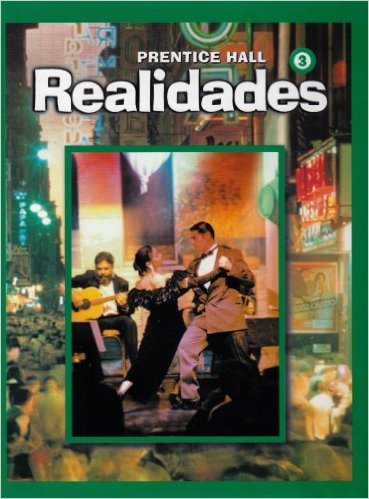
All Solutions
Page 214: Actividad 14
The present perfect tense is used when we are talking about actions that happened in the past but are related to the present.
The present perfect is formed with the present tense of the verb “haber” + past participle of the verb.
The past participle of the “-ar” ending verbs is formed by adding “-ado” to the stem. With “-ir/-er” ending verbs, the past participle is formed by adding “-ido” to the stem.
Also, there are many verbs that have an irregular past participle.
With the verbs that in the infinitive have two vowels don’t forget to put the accent marks on the “-í”.
Since we have “en la entrevista” and from the context of the sentence, we know we will choose the verb “ir”.
The subject is Juan. Therefore, we are going to use the third person singular form of the verb “haber” (ha).
And lastly, the past participle of the verb “ir” is “ido”.
The present perfect tense is used when we are talking about actions that happened in the past but are related to the present.
The present perfect is formed with the present tense of the verb “haber” + past participle of the verb.
The past participle of the “-ar” ending verbs is formed by adding “-ado” to the stem. With “-ir/-er” ending verbs, the past participle is formed by adding “-ido” to the stem.
Also, there are many verbs that have an irregular past participle.
With the verbs that in the infinitive have two vowels don’t forget to put the accent marks on the “-í”.
Since we have “las preguntas” and from the context of the sentence, we know we will choose the verb “responder”.
The subject is “yo” (Juan). Therefore, we are going to use the first person singular form of the verb “haber” (he).
And lastly, the past participle of the verb “responder” formed by adding “-ido” to stem (respond+ido).
The present perfect tense is used when we are talking about actions that happened in the past but are related to the present.
The present perfect is formed with the present tense of the verb “haber” + past participle of the verb.
The past participle of the “-ar” ending verbs is formed by adding “-ado” to the stem. With “-ir/-er” ending verbs, the past participle is formed by adding “-ido” to the stem.
Also, there are many verbs that have an irregular past participle.
With the verbs that in the infinitive have two vowels don’t forget to put the accent marks on the “-í”.
Since we have “nerviosa” and from the context of the sentence, we know we will choose the verb “ponerse”.
The subject is “yo” (Tamara). Therefore, we are going to use the first person singular form of the verb “haber” (he).
And lastly, the past participle of the verb “ponerse” is irregular (“puesto”).v
Reflexive pronouns come before the “haber” form.
The present perfect tense is used when we are talking about actions that happened in the past but are related to the present.
The present perfect is formed with the present tense of the verb “haber” + past participle of the verb.
The past participle of the “-ar” ending verbs is formed by adding “-ado” to the stem. With “-ir/-er” ending verbs, the past participle is formed by adding “-ido” to the stem.
Also, there are many verbs that have an irregular past participle.
With the verbs that in the infinitive have two vowels don’t forget to put the accent marks on the “-í”.
From the context of the sentence, we know we will choose the verb “decir”.
The subject is “el”. Therefore, we are going to use the third person singular form of the verb “haber” (ha).
And lastly, the past participle of the verb “decir” is irregular (dicho).
Reflexive pronouns come before the “haber” form.
The present perfect tense is used when we are talking about actions that happened in the past but are related to the present.
The present perfect is formed with the present tense of the verb “haber” + past participle of the verb.
The past participle of the “-ar” ending verbs is formed by adding “-ado” to the stem. With “-ir/-er” ending verbs, the past participle is formed by adding “-ido” to the stem.
Also, there are many verbs that have an irregular past participle.
With the verbs that in the infinitive have two vowels don’t forget to put the accent marks on the “-í”
From the context of the sentence, we know we will choose the verb “dar”.
The subject is “yo” (Juan). Therefore, we are going to use the first person singular form of the verb “haber” (he).
And lastly, the past participle of the verb “dar” is formed by adding “-ado” to the stem (d+ado).
The present perfect tense is used when we are talking about actions that happened in the past but are related to the present.
The present perfect is formed with the present tense of the verb “haber” + past participle of the verb.
The past participle of the “-ar” ending verbs is formed by adding “-ado” to the stem. With “-ir/-er” ending verbs, the past participle is formed by adding “-ido” to the stem.
Also, there are many verbs that have an irregular past participle.
With the verbs that in the infinitive have two vowels don’t forget to put the accent marks on the “-í”
From the context of the sentence, we know we will choose the verb “leer”.
The subject is “el”. Therefore, we are going to use the third person singular form of the verb “haber” (ha).
And lastly, the past participle of the verb “leer” is formed by adding “-ido” to the stem (le+ído).

